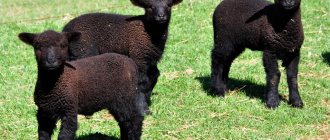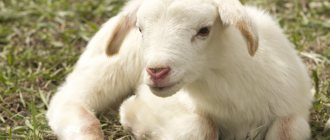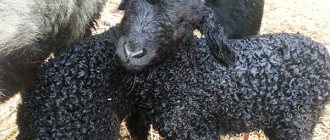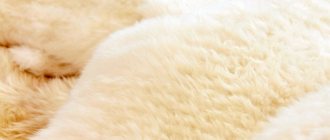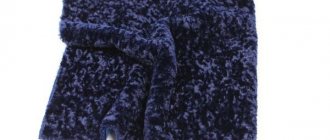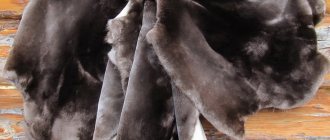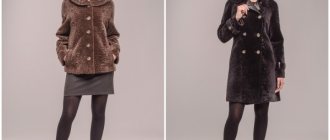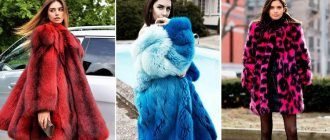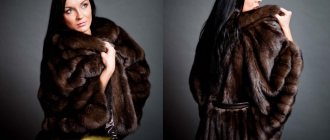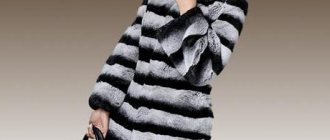In the world of luxurious fur coats, the popular mink has serious competitors. Everyone has different tastes. Some people like the long pile of shiny sable or soft arctic fox; bright fashionistas will choose a light rabbit of unimaginable colors. Sometimes you can hear about swakara fur, which is original and very expensive. Swakara - what kind of fur is hidden under such a strange name. Let's reveal a secret - this is one of the types of scribble. Let's talk about the features of fur, reveal all the secrets of the mysterious swakara, and find out how to choose the most stylish fur coat from the swakara.
About the unusual name
Swakara is an abbreviation of the English words South-West Africa KARAkul, a doodle from South-West Africa. This is an exclusive fur of newborn lambs of the Karakul breed only from Namibia, which has a magnificent pattern of flat, tight curls. Natural colors - black, gray, brown and the rare white color, which is especially valuable. The supply of fur from Namibia is limited, so it is in great demand and is sold at the fur auction in Copenhagen at high prices.
Astrakhan coat
Karakul today
Modern karakul swakara is one of the best furs popular among designers and buyers.
It has a lot of advantages, let’s see why swakara is so good:
- the fur is durable and strong;
- retains heat perfectly;
- light thin fur does not increase the volume of the figure. Many models hide their full build well;
- Shiny iridescent fur creates a chic appearance;
- caring for it is simple;
- The material is plastic, you can sew various non-standard styles.
The only disadvantages include the fairly high cost of products made from swakara.
Modern doodle swakara
Questions and answers
How to revive an astrakhan fur coat after a walk in wet snow?
If a fur coat made of astrakhan fur or astrakhan fur gets wet, it must be shaken off, ridding the fur of moisture and snow, and then hung on hangers to dry. Do not dry fur items near heating devices or under a hairdryer. Sudden temperature changes can lead to deformation and damage to clothing.
How to store products made from astrakhan fur or astrakhan fur?
As soon as the winter season is over, the astrakhan fur coat or coat is put away in the closet. The product is hung on wide soft hangers, and a fabric cover is put on top. A continuous supply of fresh air is very important for fur, so the fur coat should hang freely. In addition, care must be taken to protect against moths.
Types of karakul
Historically, there are three types of karakul - from Uzbekistan, Afghanistan and Africa. Sheep breeds of all three directions have both similar characteristics and significant differences.
Women's clothing made from karakul
What features does each direction have:
- Uzbek or Bukhara karakul (“jacket” type), the size of such skins is smaller. Uzbek fur has a light and fine texture, which is formed by tight tubular curls of different lengths. It is cheaper than others and is popular mainly in Uzbekistan itself;
- Afghan karakul has a larger pattern of flat ribbed curls and a special shine. The fur is light, of high quality, and is in great demand at international auctions. Sold mainly at auction in Helsinki;
- swakara is a new type of karakul, obtained through long-term selection. Gorgeous fine fur with a special pattern of flat curls, unique to each pelt. Such fur is expensive and is in great demand on the world market.
Fur coats from astrakhan fur
Velvet fur coats from astrakhan fur
Astrakhan fur is highly valued; it is obtained from the skins of unborn lambs that have not yet formed a curl. The flesh has a moire pattern of ribbed hair, it is flat and very short, the fur looks like shiny velvet.
Astrakhan broadtail is highly valued and in great demand, as products made from this thin silky material are delicate and elegant.
Velvet fur coat from astrakhan fur
Astrakhan fur from Namibia is also swakara, so the particularly valuable fur is the astrakhan swakara with a beautiful moire pattern. Designers offer many interesting models in natural colors and in fashionable bright colors - pink, green, blue, purple, orange and others. Models of all colors shimmer with a silky shine, but the white broadtail swakara is especially highly valued.
Not only fur coats made from broadtail swakara are trending, but also coats and other products. But this fur is thin and not very durable; it lasts for 2-3 seasons. Therefore, things made from astrakhan fur are suitable for parties and special occasions, but not for everyday use.
Karakul and broadtail - what's the difference?
It is known that karakul is made from the skins of newly born lambs of the karakul breed. For this process, individuals 1–3 days old are used. After all, the older the lamb, the coarser the wool. Each skin surprises with its special unique pattern, extraordinary lightness and silkiness.
However, not every person who is not involved in fur production issues will correctly answer the question: broadtail - whose fur?
Karakulcha is the same skins of lambs, but not yet born. It is not difficult to distinguish it from astrakhan fur: the curls are not yet formed, the hairs are short and tightly adjacent to each other, the skin has a beautiful moire pattern.
These two types of fur differ not only in origin, but also in consumer characteristics.
| Characteristics | Astrakhan | Broadtail |
| Appearance | The fur is dense, the curls are clear and fully formed. There is fur of silver, golden, black color. The rarest colors are brown and white. The skin is silky and very soft to the touch. | Unique moire pattern, not fully formed curl. The skins are small in size. Color black, gold or silver. |
| Thermal conductivity | Thanks to the dense core, it retains heat well and is not afraid of moisture. Excellent protection from the cold if the frost is not lower than -10°C. | The density of broadtail is much lower, so products made from this material are not suitable for wearing in winter. |
| Wear resistance | Durable material, excellently withstands use for 10 seasons. Fur is not wear-resistant. | Clothing made from astrakhan fur lasts no more than three years. |
| Usage | Coats and jackets, collars, men's and women's hats are made from astrakhan fur. | It is used for light coats and jackets, but most often as a trim for dresses, coats, and suits. Usually these are exclusive products intended for publication. |
Swakara models
On the catwalks there are many beautiful models of fur coats made of swakara, short fur coats, fashionable coats made of swakara, as well as other products, are in the trend of recent seasons. Designers have used the amazing flexibility of swakara to create new silhouettes.
Beige fur coat from astrakhan fur
Important. The fur can withstand temperatures down to about minus 10 degrees, as it is quite thin. Therefore, it is best suited for autumn, early winter or temperate and warm climates.
The classics and new items of the latest seasons are trending:
- classic straight cut models, usually medium or midi length. Always elegant things for any figure with long sleeves, turn-down collar, maybe a hood, pockets;
- universal trapeze - flared hem, tapered sleeves. Feminine style will hide figure imperfections. There are interesting options for young people;
- retro style, romantic model. Long, with a flared hem and wide pockets, maybe with a hood;
- fashionable shortened models with wide sleeves, original styles to the waist or mid-thigh in the form of a parka, anorak, bomber jacket, jacket;
- Oversized (O-line) looks great with astrakhan fur. Soft dropped shoulders, narrowed hem, the model made of broadtail looks original;
- ballet shoe model with a flared back (skins are loose). Usually medium length, flirty flowy style;
- The cocoon model has an hourglass silhouette, but the hem is slightly tapered. Knee length or slightly shorter for a soft feminine look;
- models with fur trim, for example with patch pockets made of other fur (usually with long pile), collars and cuffs trimmed with expensive fur, such options create a sophisticated image;
- many combined models. The trend is a combination of sheared and long-pile fur; sheared mink, rabbit, and beaver fur are suitable. Spectacular model thanks to the play of textures;
- combined models with fashionable voluminous collars made of other fluffy fur, such as silver fox, arctic fox and others;
- Astrakhan swakara can be used to trim a mouton fur coat; the trim on the cuffs and collar or the edging on the pockets and hood look beautiful;
- a fur coat made of swakara with inserts or trim from astrakhan fur is an original, elegant option.
Where to buy cheaper
It costs a lot of money to purchase items made from broadtail swakara made in Europe, but Russian fashionistas have a way out. On the Avito website and other similar sites they offer clothes made from swakara much cheaper. Companies and individuals sell almost new fur coats made from broadtail swakara, as well as coats, short fur coats, jackets and vests. There are many original combined models from Germany, Greece, Italy, delivery is available on Avito.
Fashionable blue fur coat from astrakhan fur
Designers turn the delicate flowing fur of swakara into luxurious fur coats and coats, and fashionistas have the opportunity to show off in one of them.
Swakara - many people have heard this concept. What is it – astrakhan fur or broadtail, not everyone knows what their differences are. Today we will finally dot the i's and figure it all out.
In addition, we will look at the consumer qualities of swakara and find out what models are sewn from it, in addition, we will get acquainted with the basic concepts about this fur.
Rules for caring for things made from astrakhan fur
The durability and respectable appearance of the product over the years depends on proper care and compliance with storage conditions in the summer. If your fur coat is significantly dirty, it is better to use the services of a specialized dry cleaner. However, it is quite possible to get rid of small stains and dust at home.
Here are some recommendations for caring for an astrakhan fur coat or coat:
- The surface of astrakhan or broadtail can be wiped with a sponge dipped in a soap solution.
- To remove dust, the product is laid out on a slightly damp sheet with the wrong side up and knocked out with rolled paper or a special plastic beater.
- By wiping the surface of the fur with a cotton pad soaked in a 5% vinegar solution, you can restore the original shine and silkiness.
- Contaminated areas are treated with starch. The greasy stain is covered with powder, lightly rubbed into the pile, and then cleaned with a clothes brush.
- To avoid creases and bald spots, it is not recommended to carry a bag on your shoulder or leave a brooch pinned in one place for a long time.
Under no circumstances should you wash, iron or comb the astrakhan fur. This will inevitably lead to damage to the product.
Swakara: astrakhan fur or broadtail?
The word “swakara” itself comes from the abbreviation South-West Africa KARAkul. As the name suggests, this is a South African astrakhan, famous for its non-trivial qualities. Therefore, in short, we can say that swakara is a type of broadtail from South Africa.
In karakul, as in fur, this feature is valued: a flat, very tight ribbed curl. And it is swakara that can boast of non-trivial tight and long relief curls parallel to each other.
Take a look at the photo to see what she looks like.
If you understand the “hierarchy” of karakul, then it is swakara that occupies the highest place - this is the most expensive species due to the complex selection work done by the manufacturer plus rather limited supplies to the world market. That is, swakara is smaller than other types of astrakhan and broadtail. It is sold at the Copenhagen Fur Auction.
Astrakhan sheep are the skins of unborn lambs whose curl has not yet risen and is therefore flat and ribbed. Astrakhan fur is applicable as a concept, of course, to swakara and other varieties of astrakhan fur.
It has a silky shine that is pleasing to the eye. The fur is without shine, matte and is not of very high quality. How else can you understand that swakara fur is of high quality? The fur pattern should fold into a makeshift "chest x-ray", take a look at the photo below to get an idea of what it looks like.
Karakul swakara is also the only variety that has a natural milky white color. This is the most expensive and rare astrakhan. In terms of consumer qualities, it is approximately equal to karakul - both in warmth and wearability and in other criteria.
Swakara skins are currently worth quite a lot. If we are talking about high quality curls, prepare for a budget, like for a good mink. Yes, it's expensive, but it's effective.
In the meantime, let’s see how much, and move on to discussing finished products.
Fur astrakhan fur
The uniqueness of the doodle pattern
Depending on the origin of the sheep and the method of dressing, there are many names for this fur: broadtail, astrakhan fur, yahobab, astragan, lamb, swakara. The name “karakul” or “karakulcha” from the Turkic language means “Black Lake”, after the name of the city and area in Turkestan. Now called Uzbekistan. The homeland of karakul is Central Asia.
Karakulcha is the fur of premature Karakul lambs. It has a thinner, easily stretchable skin and short, shiny fur that fits tightly to the flesh with a moiré pattern, without clearly formed curls. The beauty of broadtail fur is that the curls that have not had time to rise look and feel like velvet.
The main value lies in the beautiful moire “sketch” of the future pattern. Depending on the method of dressing, origin and color of fur, broadtail has many names. “Colored broadtail” comes in black, gray, and brown colors. The most common and valuable color is sur and antique.
Astrakhan material is not very durable, but beautiful and expensive. The cost is equal to the most expensive varieties of astrakhan fur. It has less wear, approximately 2 - 3 seasons, broadtail is not resistant to abrasion and mechanical stress, easily forms creases, and is at the end of the wear resistance table for furs. Astrakhan broadtail is used for making exclusive and fashionable items “for going out”, since its extraordinary lightness and tenderness has a downside: such products are extremely fragile.
Karakul is the fur of Karakul lambs, the skin of which is removed 1-3 days after birth. Leather fabric is thin and soft. Silky, soft, elastic, thick and shiny wool forms curls of different shapes and sizes. Each astrakhan skin is unique, its patterns are unique, like the lines on the palms of a person. The most important element that determines the value of astrakhan sheep is the curls on the skin of the astrakhan sheep, which determine the pattern of its surface. They come in different configurations, sizes, and locations.
If the curls on the skin are folded into rows and then into a pattern, such scribble is considered the most expensive. And the lowest cost is for “curly” skins, on which small curls are scattered chaotically and haphazardly. The longer the wool, the worse the quality of the curls and the less interesting their character, so the value of the skins decreases as the lambs grow. And only if the curls meet the quality requirements and are present in sufficient quantity, other criteria for evaluating the skin come into force, such as the thickness of the fur, its shine, and so on.
Based on the height of the curl, two typical types of karakul are distinguished: – flat type – characterized by lying curls of irregular, broken shape, not closed into a ring. – high type – the curl is located at a right angle to the flesh, the rows of curls look like tubes laid on their sides. The value of high karakul depends on the number and length of such tubes: the more, the better.
The palette of astrakhan is varied - black, gray and its shades, brown. Thanks to new technologies and selection, the choice of color shades is amazing - platinum, steel, gold, amber, beige. The advantage of astrakhan fur is its ability to hold its shape for architectural cut products, and the ability to create an elegant silhouette from it, thanks to its short and smooth pile.
Yahobab - skins of lambs of purebred Karakul sheep under the age of 1 month. It is characterized by overgrown, slightly silky, matte hair and loose elastic curls of various shapes. Used for sewing coats, short coats, hats, collars.
Astragan is a type of specially processed sheepskin fur, one of the highest quality furs, for the production of which modern technologies for processing the highest grade sheepskin are used. Compared to mouton, astragan fur is much lighter, more comfortable and has heat-saving, warming properties. It is superior in quality to Mouton. The astragan product is very wearable. This is explained precisely by the short haircut of the fur, which does not allow the fur to roll down and, accordingly, lose its appearance. Astragan products are elegant and light, practical and comfortable.
Types of the finest karakul
Selection work in different countries involved in the production and export of astrakhan fur was carried out in different directions. Accordingly, the main task of karakul breeders has always been and remains the desire to obtain large batches of identical skins with stable specified characteristics. This is a very difficult job, because the type and quality of astrakhan skin is determined by more than twenty parameters. Plus, capricious fashion dictates a constant change in demand for astrakhan of different types and colors. Today, there are three main types of karakul: Uzbek, Afghan astragan, the most common South African swakara, which is the most expensive type. Astrakhan fur is as durable as sheepskin.
Uzbek karakul was bred by breeders from Uzbekistan, who relied on light and thin jacket-type karakul with a special pattern. On the surface of the skin, tight curls form tubular rolls of different lengths over the entire area of the skin. Uzbek karakul is called “valek”, “bob”, “Moscow jacket”. The size of the skins is on average 11 d². The price of such fur is relatively low and therefore astrakhan fur coats are especially popular.
Afghan karakul - astragan, is distinguished by heavier and larger skins, ranging in size from 12 to 20 d². The type is flatter, characterized by a ribbed-flat curl pattern and extraordinary shine, which gives it a special chicness. Karakul from Afghanistan is very high quality and thick, so it costs more than Uzbek.
The South African karakul "swakara" is characterized by an amazingly clear flat curl, creating a magnificent ribbed pattern formed by clear, tightly rolled, low roller tubes in a parallel arrangement. It has the strength of ordinary astrakhan fur, but its thinness is close to astrakhan fur. The average size is 12-15 d². Swakara is unusually light, wears for a long time, does not require special care and can be used for sewing almost any type and model of fur clothing. Swakara has become a completely new direction in karakul writing. Namibian karakul is the most expensive.
High quality skins of any type are highly valued. The most expensive type of karakul is considered to be swakara. This is due to the excellent results of breeding work and the limited supply of goods supplied to the market. Afghan karakul is the most common and is in great demand. 90% of all gray astrakhan products are made from hides of Afghan origin. The flat, ribbed type is in fashion now and is highly prized, broad tail - the skins of unborn lambs. The valuable fur of the broadtail is distinguished by its low, shiny, silky hairline, adjacent to the skin tissue or just beginning to emerge, with a more or less pronounced moire pattern. The jacket type of karakul, which Uzbekistan specialized in, is considered obsolete.
Swakara is sold at the Copenhagen fur auction Kopenhagen Fur, Afghan karakul, mainly at the Finnish auction in Helsinki Finnish Furs Sales, partly in Copenhagen, Uzbek karakul is represented on the international market in small quantities, it is mainly sold in the domestic market of Uzbekistan.
Palette of shades of the most delicate doodle
Breeding “colored” Karakul sheep has always been an important area of breeding work in producing countries, and impressive results have been achieved along this path. Obtaining colored karakul was one of the areas of breeding work in all countries. Based on hair color, purebred colored karakul are divided into groups:
1. “Sur” or agouti is a hairline that has an uneven distribution of color along the length of the hair: a dark base with a gradual transition to a lighter tip of the hair, forming a zonal coloration of the hairline. The most valuable variety of brown astrakhan fur, it has the following “sur” colors:
a) silver - dark smoky or black hair at the base with a transition to light silver at the ends of the hair; b) golden – dark hair at the base with a transition to golden at the ends of the hair; c) bronze - brown hair of all shades at the base with a gradual transition to light bronze or orange at the ends of the hair; d) amber - brown hair at the base with a gradual transition to amber at the ends of the hair; e) platinum - dark brown or coffee-colored hair at the base with a gradual transition to light cream at the ends of the hair; f) steel (pulat sur) - black hair at the base with a gradual transition to white or steel at the ends of the hair; g) apricot flower (uriukgul) - dark brown or dark orange hair with a gradual transition to a delicate beige-brown color with a bluish tint at the ends of the hair.
2. Plain brown astrakhan fur has hair of uniform brown color in different shades, from dark to light brown. Brown skins are characterized by khalili coloring - brown with black spots or black with brown spots, symmetrically located on the skin, as well as bordering the edges with another hair that differs in color from the main one. Brown astrakhan fur is a rare color and is rarely used in its natural form. This is due to the difficulty of choosing astrakhan fur with identical curls and a wide range of colors: from chocolate to beige, from red to cold fawn.
3. Plain astrakhan of other colors is characterized by hair of all shades of gray and brown, monochromatic coloring, as well as black hair with gray hair, “with frost.”
Gray astrakhan fur is gray hair, consisting of mixed black and white hair in different proportions, forming different shades. The main charm of gray astrakhan is the play of color, which has a less interesting pattern than black astrakhan. Depending on the ratio of black to white hairs, the possible colors of the gray doodle range from light gray-blue to black with a gray stripe along the ridge. Gray astrakhan fur is an excellent material for coloring, as the neutral gray color eliminates color distortions.
At the same time, interesting color transitions are preserved - white hairs are intensely colored, and dark ones are muted. Gray astrakhan was obtained in all producing countries, but particular success was achieved in Afghanistan, where the share of gray astrakhan can reach 60%.
White astrakhan fur is the rarest, with white hair; black spots are allowed on the muzzle, ears and legs. The best results in terms of quality and quantity were achieved only in Namibia. White swakara has an even, clean, milky color. The Afghan White Doodle is a rare random drop of light grey.
4. Variegated astrakhan fur - hair with spots (spots) of a different color than the main color on the remaining area of the skin, exceeding 12 cm², except for the head, tail and legs.
Pink or guligaz is hair of pink shades, from light to dark pink, formed by mixing white and brown hair. If a gray karakul contains a certain amount of brown hairs, the skin takes on a beautiful lilac hue. This variety of karakul is called “guligaz”, translated from Uzbek as “tamarisk flower”.
5. The most common color of astrakhan fur is black, determined by the dominant gene. In black, the unique pattern becomes especially valuable. In Central Asia, black astrakhan fur is treated like a luxurious flower - a “black rose”.
Modern technologies for processing astrakhan fur
Astrakhan fur coloring is widely used in different variants. So, if the skins are used without changing the natural color of the hair, the core is dyed the same color: this allows you to hide the areas where the curls diverge, exposing the base. A similar fur defect often appears on finished products during wear. Another reason for coloring doodles is to achieve design goals; most often they change the color of gray skins by simply dipping them into a solution with dyes. Discoloration is also often used, as a result of which astrakhan (usually with the most beautiful pattern) turns from traditional black to dark beige. The disadvantage of bleaching is the harshness of the process, which “kills” the shine of the fur and its silkiness. There are also more expensive and complex technologies, such as dyeing astrakhan with a stencil, painting or bleaching some areas of the skins while maintaining the natural color in other places. The hide can be processed “suede-like” or like leather, used for double-sided fur items.
Joining astrakhan skins can be done in two ways. The first - the so-called "shovel" assembly - is the simplest, least expensive and fastest; in this case, the largest possible size rectangular or trapezoidal pieces are simply cut from the skins, which are subsequently sewn together. The second is used when processing expensive high-quality scribble: the connecting line in this case has a complex shape, since it bypasses the curls, but the result is a solid canvas without visual signs of joints.
In Russia, astrakhan fur is difficult to consider as winter fur, since thermal comfort in astrakhan fur is felt at external temperatures not lower than -10 degrees, but it is quite suitable for mild European winters. However, winter clothes made from astrakhan fur are in high demand among domestic fashionistas: firstly, this fur hides the fullness of the figure (not all women can boast of “model” shapes 90-60-90!) Secondly, it looks ideal with voluminous figures fur trim, and collars made of long fur are very relevant for Russia.
Karakul is a historical fur that has passed through centuries
The history of karakul goes back thousands of years, because sheep breeding is one of the oldest human occupations. Karakul sheep, which perfectly adapt to the semi-desert climate, have become widespread in the Middle East and northern Africa, including Namibia. Local specialization was aimed at breeding sheep with fur with tight, low, clear curls, folding into long, parallel oriented rolls.
Karakul sheep are the first type of domestic animal that began to be bred for its beautiful fur. This breed of sheep has gained immense popularity among the population of Central Asia, precisely because of its unpretentiousness and excellent adaptability to semi-desert conditions. Presumably the history of the Karakul sheep began in the 8th century in the Khorezm Khanate in Bukhara, now Uzbekistan. The ancestor of the current sheep is considered to be the Uzbek Karakul sheep.
In the 10th century, the Arab geographer and traveler Ibn-Haukal documented in writing the trade in astrakhan skins. In the 13th century, the famous traveler Marco Polo enthusiastically described karakul patterns in his notes about Central Asia. In the 15th century, karakul skin from Bukhara was brought to Rus' by the famous Russian writer and traveler from Tver, Afanasy Nikitin. In the Middle Ages until the 16th century, Bukhara merchants transported luxurious soft astrakhan skins on camels along the Great Silk Road from Asia to the Mediterranean, from where they were distributed throughout Europe. Merchants of the Bukhara Emirate sold astrakhan and broadtail in the markets of Germany, Italy, Greece, and Scandinavian countries.
In the 17th-18th centuries, merchants from Bukhara and Khiva supplied magnificent astrakhan skins to Russia. Traders offered lamb skins at the Moscow, Tobolsk and Tver markets, in Nizhny Novgorod and Irbit. In the 19th century, astrakhan fur occupied a special place at international fur auctions in New York, Leipzig, and London and was extremely popular among buyers. Until the beginning of the 20th century in 1900, the khanates of Central Asia, and later Russia, had a monopoly on the supply of karakul on the world market. Great interest in Karakul contributed to the breeding of Karakul sheep at a scientific level in Europe - in agricultural institutes in Germany and Austria.
In 1907, a batch of Karakul sheep was imported from Bukhara to Austria, 6 individuals were transported to the southwest of the African continent. Thus began the history of the development of a completely new direction in karakul-making - Namibian karakul or “svakara”. Swakara is an abbreviation of the name of the famous South African brand South-West Africa Karakul. In the 10s of the 20th century, the bulk of Karakul sheep, numbering about two million, were still located on Central Asian territory, being the property of the Bukhara emir. In 1917, with the establishment of Soviet power in Uzbekistan, the number of sheep decreased greatly. During the struggle between the bais and the “new government,” not only people, but also animals suffered. The herds were partially exterminated, 70,000 animals were driven to Iran, about 400,000 sheep were transported by landowners to Afghanistan, which marked the beginning of the Afghan karakul. In each of these countries, astrakhan culture followed its own path, which led to the creation of three types of astrakhan, similar to each other, but not identical: Uzbek, Afghan and South African astrakhan.
The newly formed Central Asian Soviet republics made the breeding of Karakul sheep the main article of the state economy, creating state farms, collective farms and breeding farms for this purpose. Many research institutes of the USSR dealt with the issues of karakul breeding. The Soviet Union was positioned as the largest producer and exporter of astrakhan skins. By the second half of the 20th century, there were about 700 enterprises in the karakul industry in the country. The sale of karakul, which accounted for 40% of fur exports, took place at the Leningrad Soyuzfur auctions, where the BUHARA KARAKUL brand was in constant high demand.
The heyday of karakul farming was noted in the 70-80s of the 20th century. At this time, up to 18 million skins were produced in the world, the lion's share of which, up to 95%, came to the market from Namibia, Afghanistan and the Soviet Union. Following the heyday, a crisis broke out, which was based on political events in the karakul-producing countries. At first, the export of skins from Afghanistan almost stopped due to ongoing military operations. Then the Soviet Union collapsed, the former republics in Central Asia became independent states. Independence did not lead to anything good: left without centralized control, the management of the karakul farming farms began to enrich themselves, promptly selling all available skins, including destroying purebred breeding sheep that were supposed to continue the breed. Breeding research stopped, records were no longer kept at breeding farms, and professionals in the field of karakul breeding became unemployed. The huge amount of karakul accumulated in the Central Asian part of the USSR was almost entirely imported to Europe, mostly to Germany, famous for its processing enterprises. Prices for astrakhan fur on the world market began to fall rapidly.
Thus, astrakhan fur has lost its status as an elite fur and popularity among buyers. This was facilitated by the fact that the small batches of skins that occasionally entered the market were of very low quality - after all, breeding work was not carried out. Following the changes in the political situation, world psychology began to change: environmentalists became more active, including those advocating for animal rights, the fashion for fur products was replaced by the propaganda of artificial materials. As a result, the global volume of karakul sold decreased by 20 times. Now the international market for astrakhan skins is characterized by the following figures: it represents about 150,000 swakara skins, about 400,000 Afghan types of astrakhan, approximately 50,000 Uzbek ones. According to some reports, about half a million more skins are sold in Uzbekistan, within the domestic market.
Triumph of the noble doodle
Karakul came into fashion at the end of the 19th century. An expensive and prestigious astrakhan fur coat, black or gray, could only be worn by the wives of high-ranking government officials and the political elite. This gave rigor and pomp to products made from astrakhan fur and astrakhan fur. A fur coat of a classic silhouette, made of black or gray astrakhan fur, was a very stylish and precious item in the wardrobe. Karakul achieved particular popularity; it was used to sew clothes, collars and cuffs for coats, hats and caps, and was used in decoration and for making accessories. At the beginning of the 20th century, children's fur coats were made from astrakhan fur, which were decorated with decorative braid and embroidery. The dream of little fashionable ladies was a white astrakhan fur coat with a muff. For adult fashionistas, an egg-shaped coat with a fox collar was made. During the war years of the 40s, astrakhan fur was in great demand, which was reflected in the shortage of assortment.
The 80s brought floor-length astrakhan fur coats, jackets and ponchos back into fashion. Astrakhan fur ceased to be associated with the age category of women of “Balzac age”, and confidently gained popularity among young people. In the early 90s, Ralph Lauren played with karakul in the folk spirit, presenting kubanka hats and Hungarian hussar caps made of karakul, decorated with cords. A hit in the winter of 1998-1999. became handbags made of colored astrakhan fur from Chanel and pink slippers from Dolce&Gabbana. Tom Ford for Gucci last season offered the finest tops made of walnut and olive broadtail. And this winter you could see broadtail of all colors on the catwalks. In recent decades, fur coats made from the finest astrakhan fur and astrakhan fur have not gone out of fashion, thanks to the latest design solutions that have breathed new life into them.
The revival of karakul as a popular fur occurred in 2004, when in Milan, at the spring show, fashion designers of the famous house Prada included in the collection a headdress made of Namibian karakul (black swakara) - the “pie”, so beloved by Soviet party leaders. The formula “new is just forgotten old” once again worked perfectly, and karakul, which many fashion trendsetters hastened to declare hopelessly outdated, found a second life. In addition to the interesting texture of the fur, the doodle is also benefited by its current rarity on the market - an indispensable condition for the material from which unique, exclusive products are sewn.
In 2005, karakul triumphantly walked the most prestigious catwalks in the world; it was used in the creation of their collections by the most famous Fashion Houses: Prada and Gucci, Dolce & Gabbana and Valentino, J. Mendel and Michael Kors, Jean Paul Gaultier and Roberto Cavalli, Missoni and Louis Vuitton . Delicate fur with an elegant, sophisticated pattern has once again risen to the peak of world fashion - and the price of astrakhan fur on the world market, always sensitive to fashion trends, has quadrupled in just three years.
Practicality of astrakhan fur, astrakhan fur and swakara
Swakara, astrakhan fur and the finest broadtail have not left the catwalks, the pages of fashion magazines and the hearts of lovers of fur and beauty for many years. Modern fashion trends have made karakul sparkle with new colors. The color range is extensive and amazing in its diversity, thanks to new processing technologies and fur dyeing. The fur of astrakhan and astrakhan fur has acquired completely new colors and shades, from amber-golden to bluish-steel, from classic black to unusual bright colors. This allows you to use astrakhan fur in various collections of famous designers, using non-standard solutions in cutting, and significantly expanding the scope of its application in the manufacture of various types of products.
The style of products made from astrakhan fur and astrakhan fur has become more daring and stylish, designed for the younger generation. Products made from astrakhan fur or astrakhan fur are incredibly beautiful, wonderful, relevant, have an original appearance, unique patterns created by unique curls.
The finest broadtail, in combination with other natural materials, is used in the manufacture of various models of clothing, which looks incomparable and gives the products a special chic. The boldness of the design idea gave rise to the most incredible, but amazingly beautiful and bright combinations of astrakhan fur with lynx or badger fur, crocodile skin, and bird feathers. Today, astrakhan fur, which has triumphantly returned to the podium of popularity after undeserved oblivion, is not just a material for sewing comfortable and practical things, but an indispensable attribute of super-fashionable wardrobes and a sign of true luxury.
Astrakhan fur is used for sewing outerwear, suits, hats, and accessories. Narrow astrakhan coats of the “glamor” type, stoles, dresses, bags and shoes are very impressive - they combine the simplicity and luxury of astrakhan, astrakhan fur and swakara. An exquisite fur coat made from astrakhan fur or astrakhan fur is light, thin, warm, pleasant to the touch, does not make you fat, and comfortable to wear. Men's clothing is also made from astrakhan fur - classic jackets and sports jackets look stylish and elegant.
What is karakul: history of origin
Karakul is fur with streaks of skin from lambs, which is removed from them on the first day after their birth. Complementing the topic, astrakhan fur is the fur of which animal, it should be noted that this fur has a thick, elastic, silky structure. Unlike other materials, it has a variety of curls.
Lambs fur
According to legend, his homeland is the territory of the Turks, today it is Uzbekistan. It appeared around the 8th century thanks to the seizure of these lands by the Arabs. Along with the conquest, they brought a lot of their own into the culture. In particular, they brought Karakul sheep and began to make fur products from them. The indigenous people noticed the fact that these animals live well in Asia.
Curls
In the 15th century, the domestic Tver explorer Afanasy Nikitin, known for his land discoveries, brought astrakhan fur to Russian lands. Since then they have become popular.
Attention ! Today, astrakhan wool continues to be supplied from Central Asia, namely from Uzbekistan, Afghanistan, Turkmenistan, Kazakhstan and some other places, in particular Iraq, South Africa, Romania and Moldova. The most valuable furs are from Uzbekistan, Afghanistan and South Africa.
History of the origin of karakul
The Karakul sheep was one of the first animals that people started breeding for their fur. The animal was distinguished not only by its beautiful fur, but also by its special unpretentiousness, which allowed it to perfectly adapt to the difficult living conditions in the desert.
The ancestor of all Karakul sheep comes from Uzbekistan, in the past – the Khorezm Khanate. The name of the fur also comes from those places. Translated into Russian, “karakul” means “black lake”. It was near this reservoir, located near Bukhara, that Karakul sheep began to be bred.
For many years, the right to breed these animals and produce expensive and beautiful fur belonged exclusively to the Bukhara Khan. And only many years later, already at the beginning of the 20th century, several individuals were sent to North Africa, in particular Namibia, where today, thanks to new technologies, a special type of karakul called “svakara” is made.
How to get karakul
In response to what karakul is, it must be pointed out that it is taken from astrakhan lambs, and astrakhan smushka with whiting and strap is taken from sheep with coarse wool. In terms of wear resistance, it is similar to sheepskin. Its natural color is black and gray. Sometimes it is painted white. Its value lies in the unusual pattern formed from wool curls. Each skin is decorated with intricate lines and swirls.
White lamb
Black astrakhan fur is divided according to its origin. It happens, for example, Uzbek, Afghan and South African.
Unlike other varieties, the first type is the cheapest. The peculiarity lies in lightness with subtlety.
Types of fur raw materials obtained from the Karakul breed
How is karakul made and what are the types of karakul? The following types of fur raw materials are known, which can be obtained from unborn or newborn lambs:
- Smushka is the skin from a Smushka sheep from four-day-old lambs. It is distinguished by its softness, matte and shiny structure, loose and braided curls.
- Moire is a canvas with a moire pattern and low hairline.
- Klyam is a canvas that has a low raised cover with manes and a moiré pattern.
- Merlushka is a soft, coarse wool, glassy-shiny and matte, on which curls of various shapes are formed.
- Webbing is a cover consisting of ring-shaped curls.
- Treasok and sak-sak - a cover consisting of ring-shaped and corkscrew-shaped curls. Has a silky texture.
- Golyak - skins with barely visible wool from four-month abortions and embryos of sheep.
- Kurakulcha - skins of four-month-old embryos.
- Yahobab - skins of one-month-old lambs that were obtained during forced slaughter.
- Treasok is the wool of six-month-old lambs.
Attention ! It is also obtained from the Karakul breed of sheepskin - the skins of adult animals. It is often dry and friable.
